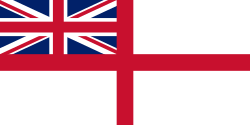History
In 1944, the Allied Naval Commander-in-Chief, Expeditionary Force, was also given the title of British Naval Commander-in-Chief, Germany. In addition, he became also Head of the Naval Division of the Control Commission for Germany, not always in attendance in Berlin, he was represented by a Deputy Head who attended the BERGOS (Chiefs of Staff) meetings. [2]
His headquarters were initially at Hamburg and then transferred later at Minden. His title was altered in 1946 to Vice Admiral Commanding, British Naval Forces, Germany. [3] In 1947 the post holders title was changed to Flag Officer Commanding, British Naval Forces, Germany. Apart from his additional role as Chief British Naval Representative in the Allied Control Commission (Germany), he was responsible for all naval matters in Western Germany, Denmark, Holland and Norway. [4]
As British Naval Commander-in-Chief, Germany, he was supported by a number of flag officers some of whose titles changed, due to an expanding of their particular command areas and duties. Rear-Admiral Harold Tom Baillie-Grohman began his appointment in 1944 as Flag Officer-in-Charge, Kiel but then became Flag Officer, Schleswig-Holstein. Baillie-Grohman's main task was eliminating remnants of the Kriegsmarine. Flag Officer, Wilhelmshaven became Flag Officer, Western Germany. [5]
In May 1951 the admiral's title was changed again to Flag Officer, Germany. [6] In 1955 the Secretary of State for Defence described the admiral's duties as "The Flag Officer, Germany, in his North Atlantic Treaty Organisation capacity as the Commander, Allied Naval Forces, Northern Area, Central Europe, is responsible to the Supreme Allied Commander, Europe, for naval planning matters in the British Zone and for the operational control of the Royal Naval forces in Germany. He is the naval member of the Commanders-in-Chief Committee (Germany) which is responsible to the Chiefs of Staff Committee in this country. The entry into force of the Paris Treaties will not affect the foregoing duties of the post until at least the future German navy is capable of performing the tasks required of naval forces in Germany."
In 1961 the post was disestablished.
The command had its headquarters in four successive locations:
This page is based on this
Wikipedia article Text is available under the
CC BY-SA 4.0 license; additional terms may apply.
Images, videos and audio are available under their respective licenses.
